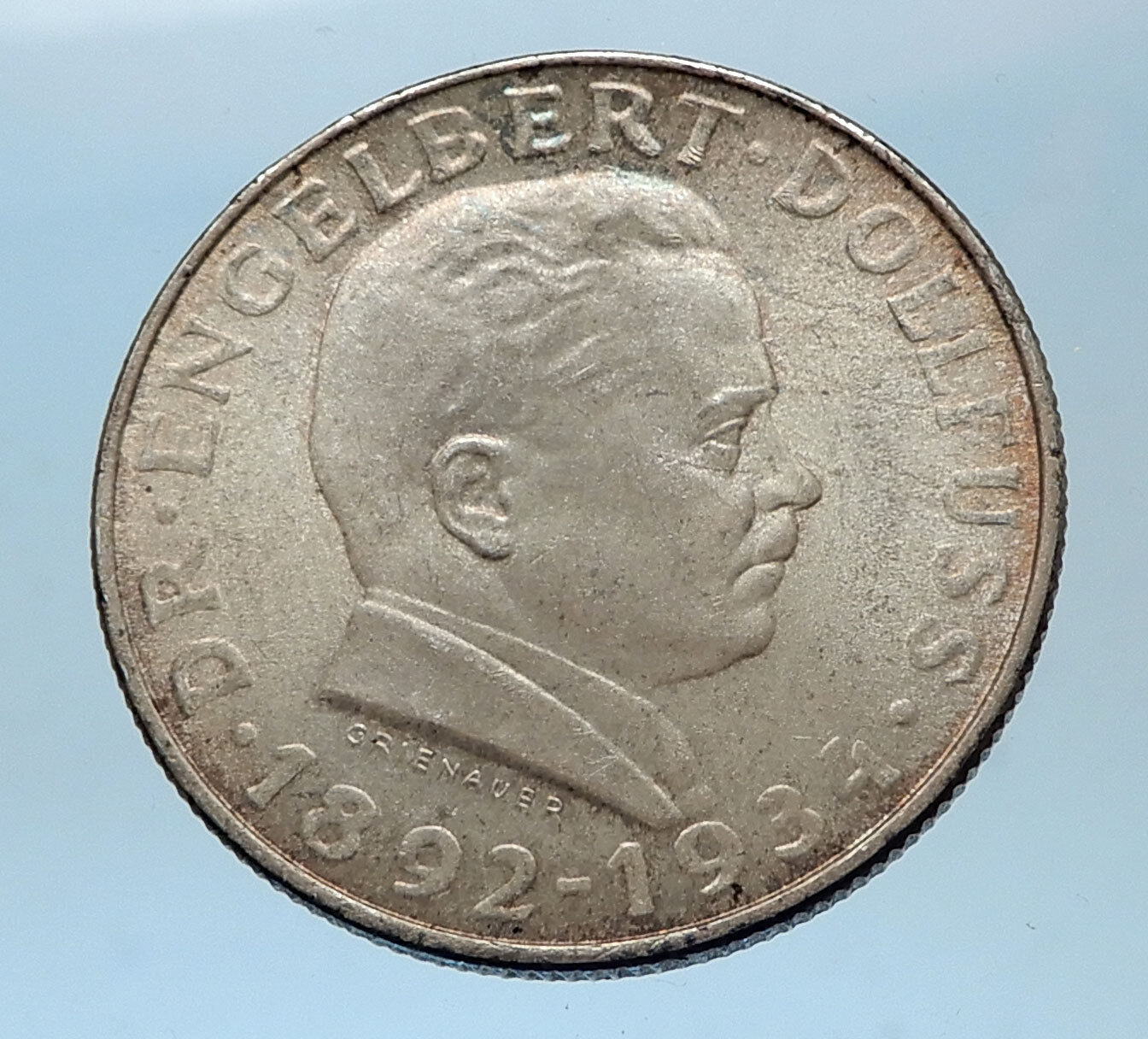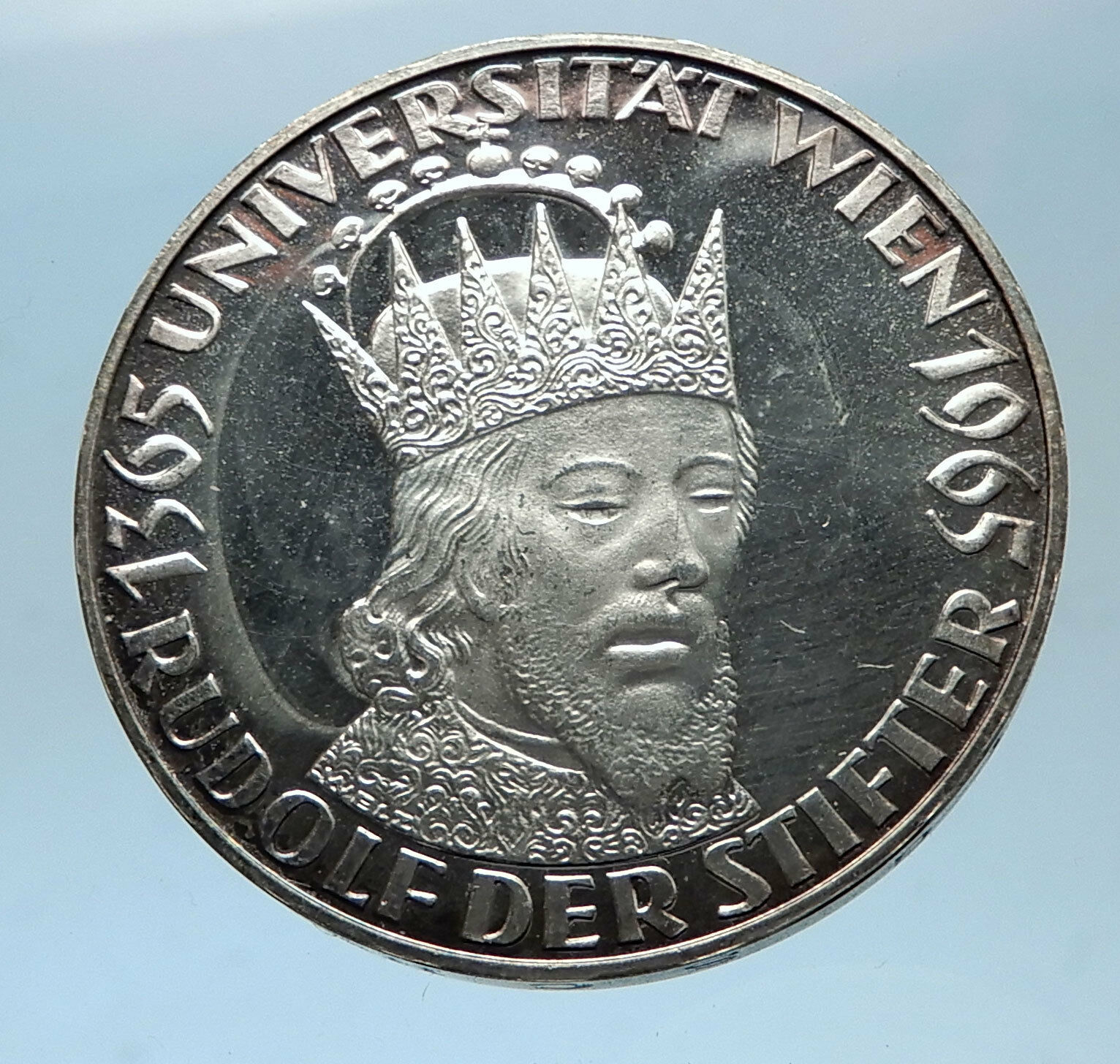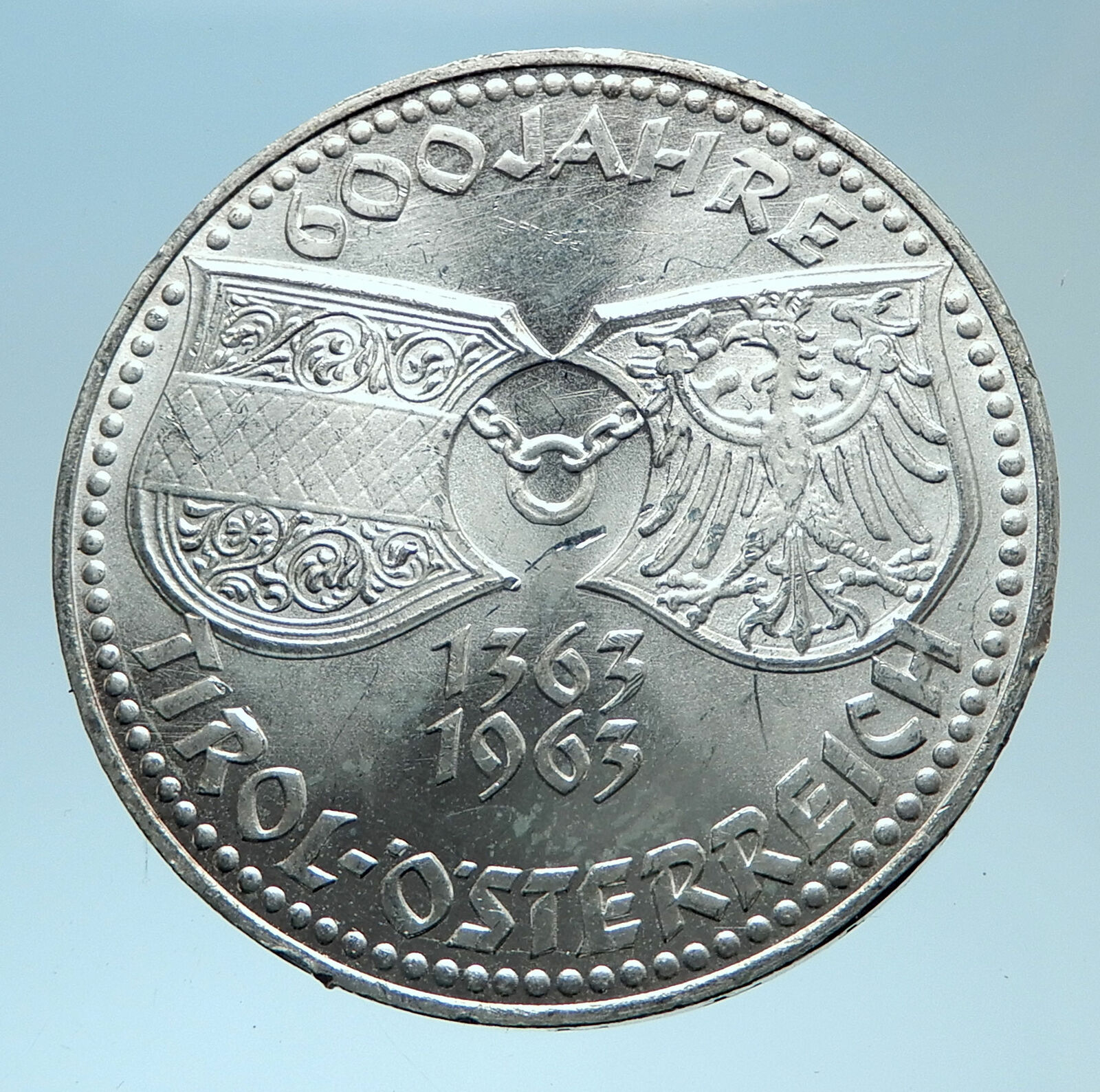|
Austria – Madonna of Mariazell
1936 Silver 5 Schilling
31mm (15.00 grams) 0.835 Silver (0.2469 oz. ASW)
Reference: KM# 2853 (1934-36*)
ÖSTERREICH FÜNF SCHILLING, Haloed double eagle with Austrian shield.
MAGNA · MATER · AUSTRIAE, Standing figure of Madonna of Mariazell.
Edge Lettering: *** FÜNF SCHILLING
You are bidding on the exact item pictured, provided with a Certificate of Authenticity and Lifetime Guarantee of Authenticity.
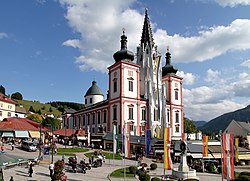 Mariazell is an Austrian city located in the southeastern state of Styria. Well known for being a hub of winter sports, 143 kilometres (89 miles) north of Graz. It is picturesquely situated in the valley of the Salza, amid the north Styrian Alps. It is a site of pilgrimage for Catholics from Austria and neighboring countries. The object of veneration is an image of the Virgin Mary reputed to work miracles, carved in lime-tree wood. This was brought to the place in 1157, and is now enshrined in a chapel adorned with objects of silver and other costly materials. The large church of which the chapel forms part was erected in 1644 as an expansion of a smaller church built by Louis I, King of Hungary, after a victory over the Ottoman Empire in 1363. Mariazell is an Austrian city located in the southeastern state of Styria. Well known for being a hub of winter sports, 143 kilometres (89 miles) north of Graz. It is picturesquely situated in the valley of the Salza, amid the north Styrian Alps. It is a site of pilgrimage for Catholics from Austria and neighboring countries. The object of veneration is an image of the Virgin Mary reputed to work miracles, carved in lime-tree wood. This was brought to the place in 1157, and is now enshrined in a chapel adorned with objects of silver and other costly materials. The large church of which the chapel forms part was erected in 1644 as an expansion of a smaller church built by Louis I, King of Hungary, after a victory over the Ottoman Empire in 1363.
There is no trace of large or enclosed settlements in the area of modern Mariazell dating from pre-Christian times or the first century A.D. The large number of Illyrian and Celtic mountain and river names in the region, such as for example the Erlauf, however, suggest small settlements by these tribes. The salt springs in Halltal were not unknown to these groups.
By 16 AD the Romans were using the salt roads of Halltal and the Traisental. According to some accounts, there also was a Roman road going to Neuhaus.
In 600 the Slavs, under the leadership of the Avars, took control of the land and settled in the mountain region and began farming. The expansion of these peoples also accounts for the existence of some of the town and mountain names today.
In 1025, Emperor Conrad II gave his sister-in-law Beatrix, married to Adalbero of Eppenstein, parts of the county in the Mürztale as a gift. With this gift came around 100 Huben, which belonged to the territory of the future market of Mariazell. There was an argument for one year over this gift involving the Reichsgericht and even the Pope. Eberhard, Archbishop of Salzburg, decided in 1151 in favor of the Monastery of St. Lambrecht. It was allowed to control part of the parish territory of Mariazell and of the dominion of Aflenz. The date, December 21, 1157, is taken off a document from Pope Adrian IV, still traditionally celebrated as the date of Mariazell’s establishment, even though it cannot be proven historically.
 In 1157, Monk Magnus came into the Zellertal with a lime-tree wood statue of the Virgin Mary and founded the first chapel there, around which the town later grew. The town’s name derived from the description “Mary in the cell”, i.e. in the monk’s chapel. In 1157, Monk Magnus came into the Zellertal with a lime-tree wood statue of the Virgin Mary and founded the first chapel there, around which the town later grew. The town’s name derived from the description “Mary in the cell”, i.e. in the monk’s chapel.
In 1344, Mariazell was elevated to the status of market town.
Between 1340 and 1380, the church was rebuilt in the Gothic style.
In 1420, the Turks of the Ottoman Empire invaded Mariazell for the first time and burned the church and the town.
In 1474, another fire devastated the town.
In 1532, the Turks returned to Mariazell and set more houses on fire.
1644: The “baroque-ization” of the church is begun by Abbot Benedikt Pierin, and the commission is given to Master Builder Sciassia. After his death the construction is continued by various other workers before being completed in 1780.
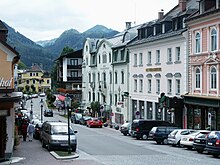 1679: Emperor Leopold I visited the shrine, and a valet in his entourage brought the plague to Mariazell. Fear and terror took hold as 156 townspeople fell victim to the disease. 1679: Emperor Leopold I visited the shrine, and a valet in his entourage brought the plague to Mariazell. Fear and terror took hold as 156 townspeople fell victim to the disease.
1683: Fears arising from yet another Ottoman invasion caused the holy statue as well as the treasury images to be sent to St. Lambrecht, from which they were returned later that year.
1742: The Empress granted Abbot Eugen Inzaghi the privileges of an Archabbot over Gollrad and Aschbach, as well as over the Mariazell cast iron works.
In 1782, Joseph Haydn wrote the Mariazell Mass, for pilgrims to the Basilica in Mariazell. The mass was commissioned at the request of the pilgrims, through a military officer.
In 1786, Emperor Joseph II dissolves the Monastery of St. Lambrecht, from which Mariazell was serviced, in the course of his cloister abolishments. The pilgrimages are hampered and later completely forbidden.
In 1798, a conflagration destroys the town; the area of Wiener Straße is especially hard hit.
1805: The Battle of Mariazell is fought in the area during the War of the Third Coalition as the French invade Austria.
1809: Faced with a French advance in the War of the Fifth Coalition, church treasures are brought to Temesvár in Hungary for security. A few weeks later, the French arrive at Mariazell. Combat operations, requisition, and crop failures lead in these years to a massive decrease in population.
1816: A great famine takes place. Archduke Johann introduces the potato and plants it in the poor fields of the area to combat hunger.
1818: Archduke Johann buys the Brandhof.
1827: Mariazell’s largest fire, which incinerates almost the entire town, and leaves the church with great fire damage, occurs on All Souls’ Night.
1828 – 1832: The town is rebuilt with great hardship and suffering.
1892: The idle boring machine of the cast-iron factory is converted to a power plant; the following year, Mariazell gets electric power for the first time.
1896: The building of the first public water service begins.
1898: The Mariazell cast iron factory is shut down.
1907: The Mariazellerbahn, finished the previous year, is opened for public transport. That same year, the Mariazell Basilica is elevated to a Basilica Minor.
1911: The Mariazellerbahn becomes electric.
1924: The first festival in the newly built festival theatre is begun.
1925: The festivals reach their high point. In the following years, financial decline brings them to an end.
1928: A gondola to the Bürger Alps becomes the first funicular to be built in Austria. That same year, the water system in expanded around the “Student-Quelle”.
1945: The Red Army enters Mariazell and takes accommodations for 5,000 men.
1948: Mariazell is elevated to the status of a city.
1955 – 1957: A general restoration of the church takes place. During these years, a by-pass and a new post office are built.
1966: The fathers of the Kremsmünster Monastery separate from the fathers of the Schottenstift, who had been in charge of the ecclesiastical leadership of Mariazell since 1949. In the following years, extensive restoration work is done on the church, the priory, and the nearby chapel. The new rosary path is also built during this time.
1976: Mariazell gains an indoor swimming pool and, a few years later, the enlargement of its Hauptschule.
1983: Pope John Paul II visits Mariazell. The papal altar is built in the main plaza. In the course of this great event, the entire city receives a façade facelift, the main plaza is redesigned, and parks are created.
1990: Thanksgiving and freedom pilgrimages from the former Eastern Bloc states bring 25,000 participants to Mariazell.
1992: The Bendictines of Kremsmünster transfer the duty of pastoral care for the pilgrimages into the custody of the founding monastery and mother cloister of St. Lambrecht.
2004: Central European Catholic Day – a pilgrimage of the people to Mariazell brings over 100,000 visitors.
2007: Pope Benedict XVI visits Mariazell to celebrate the 850th anniversary of the foundation of the Shrine of Mariazell.
 Austria, officially the Republic of Austria (German: Republik Österreich), is a federal republic and a landlocked country of over 8.5 million people in Central Europe. It is bordered by the Czech Republic and Germany to the north, Hungary and Slovakia to the east, Slovenia and Italy to the south, and Switzerland and Liechtenstein to the west. The territory of Austria covers 83,879 square kilometres (32,386 sq mi). Austria’s terrain is highly mountainous, lying within the Alps; only 32% of the country is below 500 metres (1,640 ft), and its highest point is 3,798 metres (12,461 ft). The majority of the population speak local Bavarian dialects of German as their native language, and Austrian German in its standard form is the country’s official language. Other local official languages are Hungarian, Burgenland Croatian, and Slovene. Austria, officially the Republic of Austria (German: Republik Österreich), is a federal republic and a landlocked country of over 8.5 million people in Central Europe. It is bordered by the Czech Republic and Germany to the north, Hungary and Slovakia to the east, Slovenia and Italy to the south, and Switzerland and Liechtenstein to the west. The territory of Austria covers 83,879 square kilometres (32,386 sq mi). Austria’s terrain is highly mountainous, lying within the Alps; only 32% of the country is below 500 metres (1,640 ft), and its highest point is 3,798 metres (12,461 ft). The majority of the population speak local Bavarian dialects of German as their native language, and Austrian German in its standard form is the country’s official language. Other local official languages are Hungarian, Burgenland Croatian, and Slovene.
 The origins of modern-day Austria date back to the time of the Habsburg dynasty when the vast majority of the country was a part of the Holy Roman Empire. From the time of the Reformation, many Northern German princes, resenting the authority of the Emperor, used Protestantism as a flag of rebellion. The Thirty Years War, the influence of the Kingdom of Sweden and Kingdom of France, the rise of the Kingdom of Prussia, and the Napoleonic invasions all weakened the power of the Emperor in the North of Germany, but in the South, and in non-German areas of the Empire, the Emperor and Catholicism maintained control. During the 17th and 18th centuries, Austria was able to retain its position as one of the great powers of Europe and, in response to the coronation of Napoleon as the Emperor of the French, the Austrian Empire was officially proclaimed in 1804. Following Napoleon’s defeat, Prussia emerged as Austria’s chief competitor for rule of a larger Germany. Austria’s defeat by Prussia at the Battle of Königgrätz, during the Austro-Prussian War of 1866 cleared the way for Prussia to assert control over the rest of Germany. In 1867, the empire was reformed into Austria-Hungary. After the defeat of France in the 1870 Franco-Prussian War, Austria was left out of the formation of a new German Empire, although in the following decades its politics, and its foreign policy, increasingly converged with those of the Prussian-led Empire. During the 1914 July Crisis that followed the assassination of Archduke Franz Ferdinand of Austria, Germany guided Austria in issuing the ultimatum to Serbia that led to the declaration of World War I. The origins of modern-day Austria date back to the time of the Habsburg dynasty when the vast majority of the country was a part of the Holy Roman Empire. From the time of the Reformation, many Northern German princes, resenting the authority of the Emperor, used Protestantism as a flag of rebellion. The Thirty Years War, the influence of the Kingdom of Sweden and Kingdom of France, the rise of the Kingdom of Prussia, and the Napoleonic invasions all weakened the power of the Emperor in the North of Germany, but in the South, and in non-German areas of the Empire, the Emperor and Catholicism maintained control. During the 17th and 18th centuries, Austria was able to retain its position as one of the great powers of Europe and, in response to the coronation of Napoleon as the Emperor of the French, the Austrian Empire was officially proclaimed in 1804. Following Napoleon’s defeat, Prussia emerged as Austria’s chief competitor for rule of a larger Germany. Austria’s defeat by Prussia at the Battle of Königgrätz, during the Austro-Prussian War of 1866 cleared the way for Prussia to assert control over the rest of Germany. In 1867, the empire was reformed into Austria-Hungary. After the defeat of France in the 1870 Franco-Prussian War, Austria was left out of the formation of a new German Empire, although in the following decades its politics, and its foreign policy, increasingly converged with those of the Prussian-led Empire. During the 1914 July Crisis that followed the assassination of Archduke Franz Ferdinand of Austria, Germany guided Austria in issuing the ultimatum to Serbia that led to the declaration of World War I.
 After the collapse of the Habsburg (Austro-Hungarian) Empire in 1918 at the end of World War I, Austria adopted and used the name the Republic of German-Austria (Deutschösterreich, later Österreich) in an attempt for union with Germany, but was forbidden due to the Treaty of Saint-Germain-en-Laye (1919). The First Austrian Republic was established in 1919. In the 1938 Anschluss, Austria was occupied and annexed by Nazi Germany.[14] This lasted until the end of World War II in 1945, after which Germany was occupied by the Allies and Austria’s former democratic constitution was restored. In 1955, the Austrian State Treaty re-established Austria as a sovereign state, ending the occupation. In the same year, the Austrian Parliament created the Declaration of Neutrality which declared that the Second Austrian Republic would become permanently neutral. After the collapse of the Habsburg (Austro-Hungarian) Empire in 1918 at the end of World War I, Austria adopted and used the name the Republic of German-Austria (Deutschösterreich, later Österreich) in an attempt for union with Germany, but was forbidden due to the Treaty of Saint-Germain-en-Laye (1919). The First Austrian Republic was established in 1919. In the 1938 Anschluss, Austria was occupied and annexed by Nazi Germany.[14] This lasted until the end of World War II in 1945, after which Germany was occupied by the Allies and Austria’s former democratic constitution was restored. In 1955, the Austrian State Treaty re-established Austria as a sovereign state, ending the occupation. In the same year, the Austrian Parliament created the Declaration of Neutrality which declared that the Second Austrian Republic would become permanently neutral.
Today, Austria is a parliamentary representative democracy comprising nine federal states. The capital and largest city, with a population exceeding 1.7 million, is Vienna. Austria is one of the richest countries in the world, with a nominal per capita GDP of $52,216 (2014 est.). The country has developed a high standard of living and in 2014 was ranked 21st in the world for its Human Development Index. Austria has been a member of the United Nations since 1955, joined the European Union in 1995, and is a founder of the OECD. Austria also signed the Schengen Agreement in 1995, and adopted the euro in 1999.
|





 Mariazell is an Austrian city located in the southeastern state of Styria. Well known for being a hub of winter sports, 143 kilometres (89 miles) north of Graz. It is picturesquely situated in the valley of the Salza, amid the north Styrian Alps. It is a site of pilgrimage for Catholics from Austria and neighboring countries. The object of veneration is an image of the Virgin Mary reputed to work miracles, carved in lime-tree wood. This was brought to the place in 1157, and is now enshrined in a chapel adorned with objects of silver and other costly materials. The large church of which the chapel forms part was erected in 1644 as an expansion of a smaller church built by Louis I, King of Hungary, after a victory over the Ottoman Empire in 1363.
Mariazell is an Austrian city located in the southeastern state of Styria. Well known for being a hub of winter sports, 143 kilometres (89 miles) north of Graz. It is picturesquely situated in the valley of the Salza, amid the north Styrian Alps. It is a site of pilgrimage for Catholics from Austria and neighboring countries. The object of veneration is an image of the Virgin Mary reputed to work miracles, carved in lime-tree wood. This was brought to the place in 1157, and is now enshrined in a chapel adorned with objects of silver and other costly materials. The large church of which the chapel forms part was erected in 1644 as an expansion of a smaller church built by Louis I, King of Hungary, after a victory over the Ottoman Empire in 1363.  In 1157, Monk Magnus came into the Zellertal with a lime-tree wood statue of the Virgin Mary and founded the first chapel there, around which the town later grew. The town’s name derived from the description “Mary in the cell”, i.e. in the monk’s chapel.
In 1157, Monk Magnus came into the Zellertal with a lime-tree wood statue of the Virgin Mary and founded the first chapel there, around which the town later grew. The town’s name derived from the description “Mary in the cell”, i.e. in the monk’s chapel.  1679: Emperor Leopold I visited the shrine, and a valet in his entourage brought the plague to Mariazell. Fear and terror took hold as 156 townspeople fell victim to the disease.
1679: Emperor Leopold I visited the shrine, and a valet in his entourage brought the plague to Mariazell. Fear and terror took hold as 156 townspeople fell victim to the disease.  Austria, officially the Republic of Austria (German: Republik Österreich), is a federal republic and a landlocked country of over 8.5 million people in Central Europe. It is bordered by the Czech Republic and Germany to the north, Hungary and Slovakia to the east, Slovenia and Italy to the south, and Switzerland and Liechtenstein to the west. The territory of Austria covers 83,879 square kilometres (32,386 sq mi). Austria’s terrain is highly mountainous, lying within the Alps; only 32% of the country is below 500 metres (1,640 ft), and its highest point is 3,798 metres (12,461 ft). The majority of the population speak local Bavarian dialects of German as their native language, and Austrian German in its standard form is the country’s official language. Other local official languages are Hungarian, Burgenland Croatian, and Slovene.
Austria, officially the Republic of Austria (German: Republik Österreich), is a federal republic and a landlocked country of over 8.5 million people in Central Europe. It is bordered by the Czech Republic and Germany to the north, Hungary and Slovakia to the east, Slovenia and Italy to the south, and Switzerland and Liechtenstein to the west. The territory of Austria covers 83,879 square kilometres (32,386 sq mi). Austria’s terrain is highly mountainous, lying within the Alps; only 32% of the country is below 500 metres (1,640 ft), and its highest point is 3,798 metres (12,461 ft). The majority of the population speak local Bavarian dialects of German as their native language, and Austrian German in its standard form is the country’s official language. Other local official languages are Hungarian, Burgenland Croatian, and Slovene. The origins of modern-day Austria date back to the time of the Habsburg dynasty when the vast majority of the country was a part of the Holy Roman Empire. From the time of the Reformation, many Northern German princes, resenting the authority of the Emperor, used Protestantism as a flag of rebellion. The Thirty Years War, the influence of the Kingdom of Sweden and Kingdom of France, the rise of the Kingdom of Prussia, and the Napoleonic invasions all weakened the power of the Emperor in the North of Germany, but in the South, and in non-German areas of the Empire, the Emperor and Catholicism maintained control. During the 17th and 18th centuries, Austria was able to retain its position as one of the great powers of Europe and, in response to the coronation of Napoleon as the Emperor of the French, the Austrian Empire was officially proclaimed in 1804. Following Napoleon’s defeat, Prussia emerged as Austria’s chief competitor for rule of a larger Germany. Austria’s defeat by Prussia at the Battle of Königgrätz, during the Austro-Prussian War of 1866 cleared the way for Prussia to assert control over the rest of Germany. In 1867, the empire was reformed into Austria-Hungary. After the defeat of France in the 1870 Franco-Prussian War, Austria was left out of the formation of a new German Empire, although in the following decades its politics, and its foreign policy, increasingly converged with those of the Prussian-led Empire. During the 1914 July Crisis that followed the assassination of Archduke Franz Ferdinand of Austria, Germany guided Austria in issuing the ultimatum to Serbia that led to the declaration of World War I.
The origins of modern-day Austria date back to the time of the Habsburg dynasty when the vast majority of the country was a part of the Holy Roman Empire. From the time of the Reformation, many Northern German princes, resenting the authority of the Emperor, used Protestantism as a flag of rebellion. The Thirty Years War, the influence of the Kingdom of Sweden and Kingdom of France, the rise of the Kingdom of Prussia, and the Napoleonic invasions all weakened the power of the Emperor in the North of Germany, but in the South, and in non-German areas of the Empire, the Emperor and Catholicism maintained control. During the 17th and 18th centuries, Austria was able to retain its position as one of the great powers of Europe and, in response to the coronation of Napoleon as the Emperor of the French, the Austrian Empire was officially proclaimed in 1804. Following Napoleon’s defeat, Prussia emerged as Austria’s chief competitor for rule of a larger Germany. Austria’s defeat by Prussia at the Battle of Königgrätz, during the Austro-Prussian War of 1866 cleared the way for Prussia to assert control over the rest of Germany. In 1867, the empire was reformed into Austria-Hungary. After the defeat of France in the 1870 Franco-Prussian War, Austria was left out of the formation of a new German Empire, although in the following decades its politics, and its foreign policy, increasingly converged with those of the Prussian-led Empire. During the 1914 July Crisis that followed the assassination of Archduke Franz Ferdinand of Austria, Germany guided Austria in issuing the ultimatum to Serbia that led to the declaration of World War I. After the collapse of the Habsburg (Austro-Hungarian) Empire in 1918 at the end of World War I, Austria adopted and used the name the Republic of German-Austria (Deutschösterreich, later Österreich) in an attempt for union with Germany, but was forbidden due to the Treaty of Saint-Germain-en-Laye (1919). The First Austrian Republic was established in 1919. In the 1938 Anschluss, Austria was occupied and annexed by Nazi Germany.[14] This lasted until the end of World War II in 1945, after which Germany was occupied by the Allies and Austria’s former democratic constitution was restored. In 1955, the Austrian State Treaty re-established Austria as a sovereign state, ending the occupation. In the same year, the Austrian Parliament created the Declaration of Neutrality which declared that the Second Austrian Republic would become permanently neutral.
After the collapse of the Habsburg (Austro-Hungarian) Empire in 1918 at the end of World War I, Austria adopted and used the name the Republic of German-Austria (Deutschösterreich, later Österreich) in an attempt for union with Germany, but was forbidden due to the Treaty of Saint-Germain-en-Laye (1919). The First Austrian Republic was established in 1919. In the 1938 Anschluss, Austria was occupied and annexed by Nazi Germany.[14] This lasted until the end of World War II in 1945, after which Germany was occupied by the Allies and Austria’s former democratic constitution was restored. In 1955, the Austrian State Treaty re-established Austria as a sovereign state, ending the occupation. In the same year, the Austrian Parliament created the Declaration of Neutrality which declared that the Second Austrian Republic would become permanently neutral.

